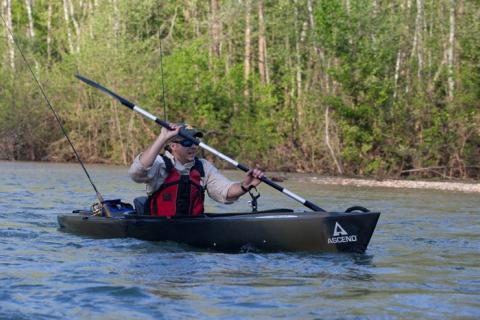
In the Southern United States river fishing has year long possibilities for bass fishing, especially out of a kayak. One of my favorite times is Fall. While many ways to catch river bass exist for Fall fishing, these three are my favorite places to locate fish in a river.
In this article you'll find a video on How to Fish the Ned Rig-LINK and a video on How to Tie the Texas Rig - LINK.
1. Look for the Big Direction Changes
 |
| Zoom Super Fluke Jr in Watermelon Seed |
Anytime you see a big turn in the river look for cover. I especially love hair pin turns that have a downed tree or boulders in the channel. That tree is going to hold fish every time. You may or may not be able to catch them but they are there.
I remember learning to fish rivers and having a guy in a kayak next to me tell me about this. I had cast to that tree more than a dozen times and not a bump. He told me I needed to present the bait like a baitfish. I needed to let the current walk my bait under the tree and not try to bring it back against the current. As soon as I slowed down and let the river do the work, fish on!
The direction changes funnel current and divert current through the structure which creates many opportunities for bass to lay in a small eddy and ambush. This allows them to conserve energy and have their food basically delivered to them.
![]() Extra Tip: I like to fish with a Zoom Fluke with a smaller baitfish profile for this application rigged weightless.
Extra Tip: I like to fish with a Zoom Fluke with a smaller baitfish profile for this application rigged weightless.
![]() Extra Tip: How to Get Your Kayak Fishing Ready - LINK
Extra Tip: How to Get Your Kayak Fishing Ready - LINK
2. Find Underwater Islands Near the Channel
An underwater island sounds like you’d need to be fishing a pretty big river to find one but it’s not true. An island can really be the same thing as a hump in a lake. I like to refer to them as islands because it’s a popular spot, just like the islands. Find one in or right off the channel and you will find fish.
If you run electronics on your kayak, these will be easier to find. If not, try throwing a fixed depth diving crankbait. If the river is typically about eight feet deep in the channel, throw a crankbait that dives to six feet. A two foot rise in or nearby the channel is significant.
![]() Extra Tip: 3 Reasons You Need a Fish Finder for Your Kayak - LINK
Extra Tip: 3 Reasons You Need a Fish Finder for Your Kayak - LINK
Think of it this way: If a 20 inch largemouth is about six inches tall from his belly to his dorsal fin, a two foot change would be four times the height difference. That would be the same as going from six feet to 24 feet for a tall human. The difference between standing in a shipping container and a basketball gym.
Fish will relate to that change. Lots of them. Once you find it, pepper the island with baits all along the edges where it falls back into the channel.
![]() Extra Tip: A Ned Rig is perfect for picking apart an island if fish are not actively hitting the crankbait.
Extra Tip: A Ned Rig is perfect for picking apart an island if fish are not actively hitting the crankbait.
3. Don't Forget the River Bank
River fish are different than lake fish. They don’t have the ability to choose from as many spots to hunt and reside. To me it seems their goal is most often, don’t expend energy fighting current and eat. Pretty simple, right? Keeping those two in mind it makes a little more sense why you would want to throw at the banks.
In rivers, where the water meets the shore is rarely the edge of the water to the fish. Riverbanks are very often undercut, sometimes a couple of feet or more. These cuts provide shelter, current deflection and a conveyor belt of food that comes right to them.
Think of a turtle or small lizard that might wander to the water’s edge. It may seem all clear but from underneath the bank a predator springs as soon as a ripple appears. Us this to your advantage. Often times I will actually throw on the bank and bring the lure into the water slowly.
![]() Extra Tip: Weedless lures are best for casting on to the bank. I particularly like a Texas rigged creature bait in this application.
Extra Tip: Weedless lures are best for casting on to the bank. I particularly like a Texas rigged creature bait in this application.
- 4596 views

